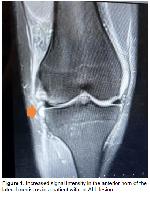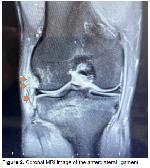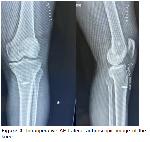Research and Publication Ethics: Approval for the study was given by the local Ethics Committee (2023/12-06). Data collection and evaluation was done in accordance with the Declaration of Helsinki.
In this study retrospective analysis was conducted on a group of 48 patients, ranging in age from 17 to 41 years, who performed surgery for anterior cruciate ligament rupture between the years 2021 and 2023. All patients were informed about the treatment and their written consent was obtained. The imaging and medical information were obtained from the electronic patient records using the Picture Archiving and Communication System (PACS) software at our institution.
Inclusion And Exclusion Criteria: All patient became a standard radiological evaluation using MRI during admission. The inclusion criteria consists of patients who exhibited rupture of the ACL and/or ALL on MRI images, patients who reported experiencing a feeling of rotation and unloading in the knee, and patients who demonstrated at least one positive result on the anterior drawer, pivot shift, or lachman test during physical examination.
The study excluded patients who had undergone anterior cruciate ligament surgery in the past, had a follow-up time of less than 1 year, encountered unsuccessful tunnel deployment, had postoperative infection, or had reduced knee range of motion before the operation.
Rehabilitation: Each patient was scheduled for follow-up examinations on the 15th day, 1st month, 3rd month, 6th month, 1st year, and subsequently annually. During these appointments, all patients performed the same exercise program. Passive activities to flex and extend the knee, straight leg raises, heel slides against the wall, and quadriceps stretching exercises were initiated on the first day after the surgery. During the first 20-day period, the patient was walked using crutches with partial weight-bearing. The period of this time was 30 days in patients who underwent meniscal repair. Leg press workouts were initiated at the conclusion of the second month, with a steady increment in the weight. Patients were advised to avoid from high-impact activities, such as running, for the initial 3 months and from playing football until the 7th month, in order to reduce strain on the knee joint.
The Lysholm knee scoring system, which ranges from 100 to 90 points for an excellent result, 89 to 80 points for a good result, 79 to 70 points for a fair result, and less than 70 points for a poor result, was utilized for clinical evaluation. Additionally, the Tegner activity scale, which ranges from 0 to 10, was also employed. The study recorded the presence of a meniscal tear along with the treatment method used for the tear, rates of retear, MRI findings including rupture of the ACL increased signal in the anterior root of the lateral meniscus, Segond fracture, and any additional meniscal tears. Persistent instability complaints and postoperative functional outcomes were also recorded.
Surgical Technique
ACL Repair: The surgical procedure was performed on all patients while they were under spinal anesthesia in a supine position. Tendons from the musculus semitendinosus and musculus gracilis were taken from the same knee. An arthroscope was introduced into the knee and the medial portal was used as the procedure portal. Removed fragments of damaged cruciate ligaments. Anatomic single bundle anterior cruciate ligament reconstruction surgery was carried out. The anatomical ACL footprint for the femoral tunnel was utilized. The positioning of the femoral tunnel was assessed following the insertion of the endobutton using radiographic imaging (Figure 1). The tibial tunnel was again created using the anatomical ACL footprint. The Biorci screw and U nail were utilized for fixing to the tibial tunnel. Following the graft insertion, the arthroscope demonstrated that the graft did not experience compression when the patient's knee was in either a flexed or extended position. Ultimately, the strain of the graft was examined using a probe.

Büyütmek İçin Tıklayın |
Figure 1: Increased signal intensity in the anterior horn of the lateral meniscus in a patient with an ALL lesion |
Meniscus Repair: Concurrently with the rupture of the ACL, a partial meniscectomy was performed using an arthroscopic punch and shaver to address deteriorated tears in the white area that had a beak-like morphology and were not receptive to repair. In cases of non-displaced root lacerations, the injured ends were regenerated with a shaver and let to heal by conservative treatments. The Bucket handle, horizontal, displaced root tears, and tears in the red area were repaired with outside inside all inside, outside to inside, inside outside all inside techniques as well as with the assist of a suture passer.
Statistical Analysis: Histogram and Q-Q plots were examined, Shapiro-Wilks test was applied to assess the data normality. Levene test was used to test variance homogeneity. To compare the differences between groups, either a two-sided independent samples t test were applied for continuous variables, Pearsons χ2 test was applied for categorical variables. Analysis were conducted using R 4.3.2 softwares. Significance level was accepted as p<0.05.








